Numerical Investigation on Mechanisms of MHD Heat Flux Mitigation in Hypersonic Flows
Abstract
1. Introduction
2. Numerical Methods and Verification
2.1. Governing Equations and Numerical Methods
2.2. Electrical Conductivity Model
2.3. Code Verification
2.3.1. Hypersonic Flow over a Cylinder
2.3.2. Theoretical Solution of Stagnation Point MHD Flow
3. Results and Discussion
3.1. Problem Set-Up
3.2. Surface Heat Flux Distribution Considering Chemical Nonequilibrium Effect
3.3. Flow Mechanisms Analysis in Different Regions
3.3.1. Stagnation Point Region
3.3.2. Zone and Zone
3.3.3. Zone
3.3.4. Zone
4. Conclusions
- (1)
- The external magnetic field can effectively reduce the heat flux at the stagnation point. Under the freestream conditions and the effect of magnetic field in this paper, the stagnation point heat flux decreases by 18.7%. Numerical experiments reveal that the current viewpoint that the increase of shock stand-off distance leads to the decrease in stagnation point heat flux is not reasonable. In fact, the increase in boundary layer thickness due to the effect of counter-flow Lorentz force, which is equivalent to adding an adverse pressure gradient, is the main reason.
- (2)
- In the head region of the blunt body, the relative surface heat flux shows a complex trend of rising and falling under the effect of external magnetic field. There are two basic mechanisms. On the one hand, the counter-flow Lorentz force results in the increase in boundary layer thickness, which helps to reduce the surface heat flux. On the other hand, the Joule heating directly increases the static temperature behind bow shock, which enhances the surface heat flux. Since the above two mechanisms are dominant alternately in different regions, the surface heat flux exhibits rise and fall under the effect of external magnetic field.
- (3)
- In the shoulder region of blunt body, there is another mechanism. When the local magnetic interaction is large enough, the Lorentz force component, normal to streamline, may change the flow direction of the fluid elements, causing the streamline to deviate from the wall or even separate. The flow separation and reattachment would significantly affect the surface heat flux.
- (4)
- In the large area downstream of the blunt body, it is found that the surface heat flux could still be significantly reduced by more than 30%. This is because of the “upstream historical effect”, which is that the velocity deceleration and temperature enhancement effects induced by the external magnetic field in the upstream sphere region need time to recover with downstream development. The heat flux reduction effect of magnetic field can be extended downstream to about 1.5 m in this paper.
Author Contributions
Funding
Institutional Review Board Statement
Informed Consent Statement
Data Availability Statement
Acknowledgments
Conflicts of Interest
References
- Anderson, J.D. Hypersonic and High Temperature Gas Dynamics; AIAA: Reston, WV, USA, 2000. [Google Scholar]
- Resler, E., Jr.; Sears, W. The prospects for magneto-aerodynamics. J. Aerosp. Sci. 1958, 25, 235–245. [Google Scholar] [CrossRef]
- Meyer, R.C. On reducing aerodynamic heat-transfer rates by magnetohydrodynamic techniques. J. Aerosp. Sci. 1958, 25, 561–566. [Google Scholar] [CrossRef]
- Bush, W.B. Magnetohydrodynamic-hypersonic flow past a blunt body. J. Aerosp. Sci. 1958, 25, 685–690. [Google Scholar] [CrossRef]
- Bush, W.B. The stagnation-point boundary layer in the presence of an applied magnetic field. J. Aerosp. Sci. 1961, 28, 610–611. [Google Scholar] [CrossRef]
- Gülhan, A.; Esser, B.; Koch, U.; Siebe, F.; Riehmer, J.; Giordano, D.; Konigorski, D. Experimental verification of heat-flux mitigation by electromagnetic fields in partially-ionized-argon flows. J. Spacecr. Rocket. 2009, 46, 274–283. [Google Scholar] [CrossRef]
- Fujino, T.; Funaki, I.; Sugita, H.; Mizuno, M.; Ishikawa, M. Numerical Analyses on Flow Control Around Blunt Body “OREX” by Magnetic Field. In Proceedings of the 34th AIAA Plasmadynamics and Lasers Conference, Orlando, FL, USA, 23–26 June 2003; p. 3760. [Google Scholar]
- Yoshino, T.; Fujino, T.; Ishikawa, M. Numerical study of thermal protection utilizing magnetohydrodynamic technology in super-orbital reentry flight. In Proceedings of the 41st Plasmadynamics and Lasers Conference, Chicago, FL, USA, 28 June–1 July 2010; p. 4486. [Google Scholar]
- Khan, O.; Hoffmann, K.; Dietiker, J.F. Validity of low magnetic Reynolds number formulation of magnetofluiddynamics. In Proceedings of the 38th AIAA Plasmadynamics and Lasers Conference in Conjunction with the 16th International Conference on MHD Energy Conversion, Miami, FL, USA, 2–28 June 2007; p. 4374. [Google Scholar]
- Damevin, H.M.; Hoffmann, K.A. Numerical simulations of magnetic flow control in hypersonic chemically reacting flows. J. Thermophys. Heat Transf. 2002, 16, 498–507. [Google Scholar] [CrossRef]
- Bityurin, V.; Bocharov, A. MHD heat flux mitigation in hypersonic flow around a blunt body with ablating surface. J. Phys. Appl. Phys. 2018, 51, 264001. [Google Scholar] [CrossRef]
- Nagata, Y.; Otsu, H.; Yamada, K.; Abe, T. Influence of hall effect on electrodynamic flow control for weakly ionized flow. In Proceedings of the 43rd AIAA Plasmadynamics and Lasers Conference, New Orleans, LA, USA, 25–28 June 2012; p. 2734. [Google Scholar]
- Fujino, T.; Takahashi, T. Numerical simulation of mars entry flight using magnetohydrodynamic parachute effect. In Proceedings of the 47th AIAA Plasmadynamics and Lasers Conference, Washington, DC, USA, 13–17 June 2016; p. 3227. [Google Scholar]
- Bityurin, V.; Bocharov, A. On efficiency of heat flux mitigation by the magnetic field in MHD re-entry flow. In Proceedings of the 42nd AIAA Plasmadynamics and Lasers Conference in Conjunction with the 18th International Conference on MHD Energy Conversion (ICMHD), Honolulu, HI, USA, 27–30 June 2011; p. 3463. [Google Scholar]
- Bisek, N.; Boyd, I.; Poggie, J. Three dimensional simulations of hypersonic MHD flow control. In Proceedings of the 40th AIAA Plasmadynamics and Lasers Conference, San Antonio, TX, USA, 22–25 June 2009; p. 3731. [Google Scholar]
- Bisek, N.J.; Boyd, I.D.; Poggie, J. Numerical study of magnetoaerodynamic flow around a hemisphere. J. Spacecr. Rocket. 2010, 47, 816–827. [Google Scholar] [CrossRef]
- Fujino, T.; Yoshino, T.; Ishikawa, M. Numerical analysis of reentry trajectory coupled with magnetohydrodynamics flow control. J. Spacecr. Rocket. 2008, 45, 911–920. [Google Scholar] [CrossRef]
- Li, K.; Liu, J.; Liu, W. Mechanism analysis of magnetohydrodynamic heat shield system and optimization of externally applied magnetic field. Acta Astronaut. 2017, 133, 14–23. [Google Scholar] [CrossRef]
- Khan, O.U.; Hoffmann, K.A.; Dietiker, J.F. Computational aspects of high-speed flows with applied magnetic field. IEEE Trans. Magn. 2006, 42, 389–397. [Google Scholar] [CrossRef]
- Khan, O.; Hoffmann, K. Temperature and Stress Distributions within a Body in High Speed Flow with and without Applied Magnetic Field. In Proceedings of the 38th AIAA Plasmadynamics and Lasers Conference In conjunction with the 16th International Conference on MHD Energy Conversion, Miami, FL, USA, 25–28 June 2007; p. 4368. [Google Scholar]
- Bird, R.B. Transport phenomena. Appl. Mech. Rev. 2002, 55, R1–R4. [Google Scholar] [CrossRef]
- Wilke, C. A viscosity equation for gas mixtures. J. Chem. Phys. 1950, 18, 517–519. [Google Scholar] [CrossRef]
- Kee, R.J.; Rupley, F.M.; Miller, J.A. The Chemkin Thermodynamic Data Base; Technical Report; Sandia National Lab.: Livermore, CA, USA, 1990. [Google Scholar]
- Shercliff, J.A. Textbook of Magnetohydrodynamics; Pergamon Press: Oxford, UK, 1965. [Google Scholar]
- Gao, Z.; Jiang, C.; Lee, C. Improvement and application of wall function boundary condition for high-speed compressible flows. Sci. China Technol. Sci. 2013, 56, 2501–2515. [Google Scholar] [CrossRef]
- Gao, Z.; Jiang, C.; Pan, S.; Lee, C.H. Combustion heat-release effects on supersonic compressible turbulent boundary layers. AIAA J. 2015, 53, 1949–1968. [Google Scholar] [CrossRef]
- Gao, Z.X.; Jiang, C.W.; Lee, C.H. A new wall function boundary condition including heat release effect for supersonic combustion flows. Appl. Therm. Eng. 2016, 92, 62–70. [Google Scholar] [CrossRef]
- Gao, Z.X.; Xue, H.C.; Zhang, Z.C.; Liu, H.P.; Lee, C.H. A hybrid numerical scheme for aeroheating computation of hypersonic reentry vehicles. Int. J. Heat Mass Transf. 2018, 116, 432–444. [Google Scholar] [CrossRef]
- Roe, P.L. Approximate Riemann solvers, parameter vectors, and difference schemes. J. Comput. Phys. 1981, 43, 357–372. [Google Scholar] [CrossRef]
- Van Leer, B. Towards the ultimate conservative difference scheme. V. A second-order sequel to Godunov’s method. J. Comput. Phys. 1979, 32, 101–136. [Google Scholar] [CrossRef]
- Yoon, S.; Jameson, A. Lower-upper symmetric-Gauss-Seidel method for the Euler and Navier-Stokes equations. AIAA J. 1988, 26, 1025–1026. [Google Scholar] [CrossRef]
- Gupta, R.N.; Yos, J.M.; Thompson, R.A.; Lee, K.P. A Review of Reaction Rates and Thermodynamic and Transport Properties for an 11-Species Air Model for Chemical and Thermal Nonequilibrium Calculations to 30,000 K; NASA RP-1232; 1990. Available online: https://ntrs.nasa.gov/citations/19900017748 (accessed on 23 August 2022).
- Bisek, N.J.; Boyd, I.D.; Poggie, J. Numerical study of plasma-assisted aerodynamic control for hypersonic vehicles. J. Spacecr. Rocket. 2009, 46, 568–576. [Google Scholar] [CrossRef]
- Asinovsky, E.; Kirillin, A.; Pakhomov, E.; Shabashov, V. Experimental investigation of transport properties of low-temperature plasma by means of electric arc. Proc. IEEE 1971, 59, 592–601. [Google Scholar] [CrossRef]
- Fujino, T.; Ishikawa, M. Numerical simulation of control of plasma flow with magnetic field for thermal protection in earth reentry flight. IEEE Trans. Plasma Sci. 2006, 34, 409–420. [Google Scholar] [CrossRef]
- Raizer, Y.P.; Allen, J.E. Gas Discharge Physics; Springer: Berlin, Germany, 1991; Volume 1. [Google Scholar]
- MacCormack, R. Evaluation of the low magnetic Reynolds number approximation for aerodynamic flow calculations. In Proceedings of the 36th AIAA Plasmadynamics and Lasers Conference, Toronto, ON, Canada, 6–9 June 2005; p. 4780. [Google Scholar]
- Yos, J.M. Transport Properties of Nitrogen, Hydrogen, Oxygen, and Air to 30,000 K; Technical Report; Avco Corp.: Wilmington, MA, USA, 1963. [Google Scholar]
- Martinez Schramm, J.; Hannemann, K.; Beck, W.; Karl, S. Cylinder shock layer density profiles measured in high enthalpy flows in HEG. In Proceedings of the 22nd AIAA Aerodynamic Measurement Technology and Ground Testing Conference, St. Louis, MI, USA, 24–26 June 2002; p. 2913. [Google Scholar]
- Poggie, J.; Gaitonde, D.V. Magnetic control of flow past a blunt body: Numerical validation and exploration. Phys. Fluids 2002, 14, 1720–1731. [Google Scholar] [CrossRef]
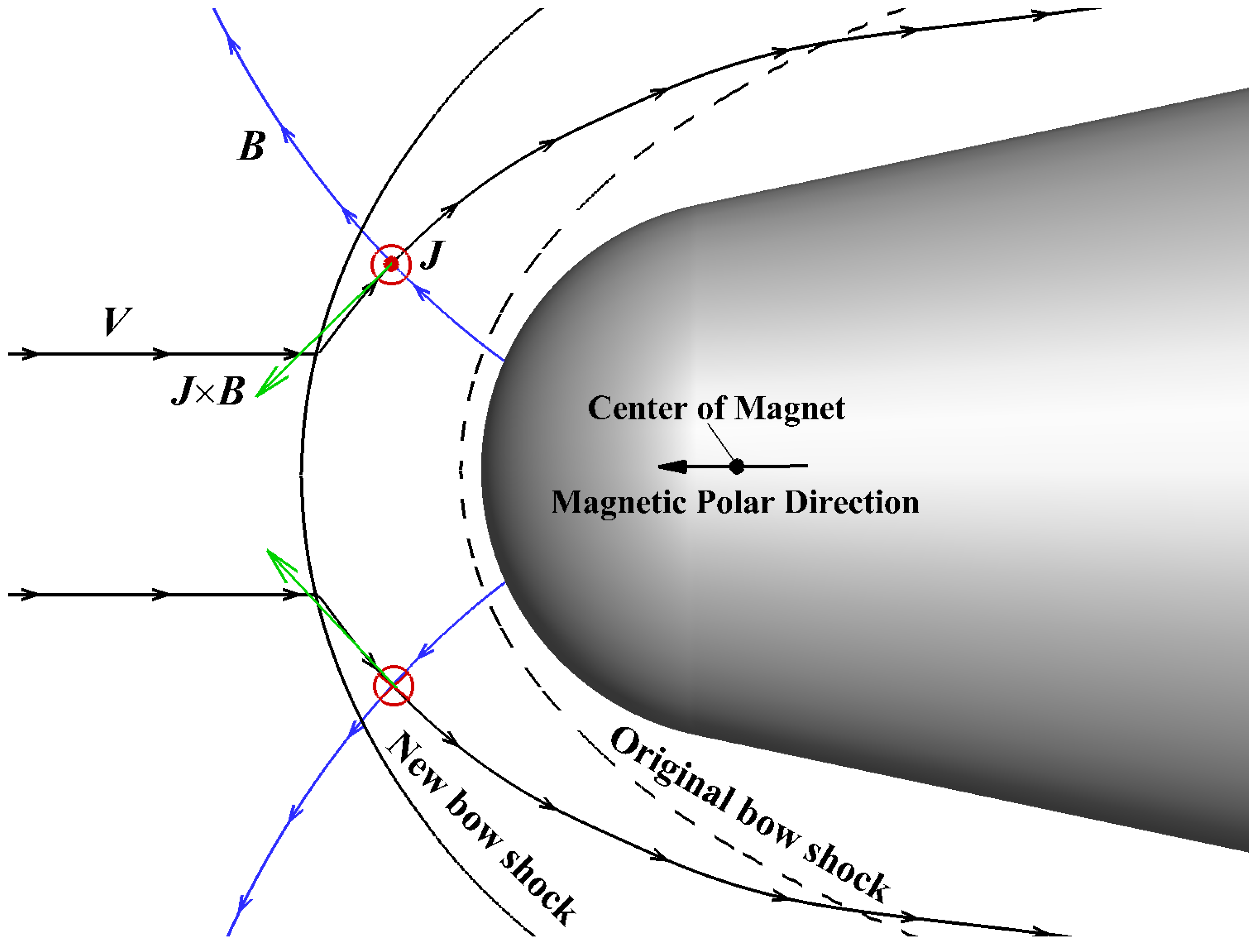
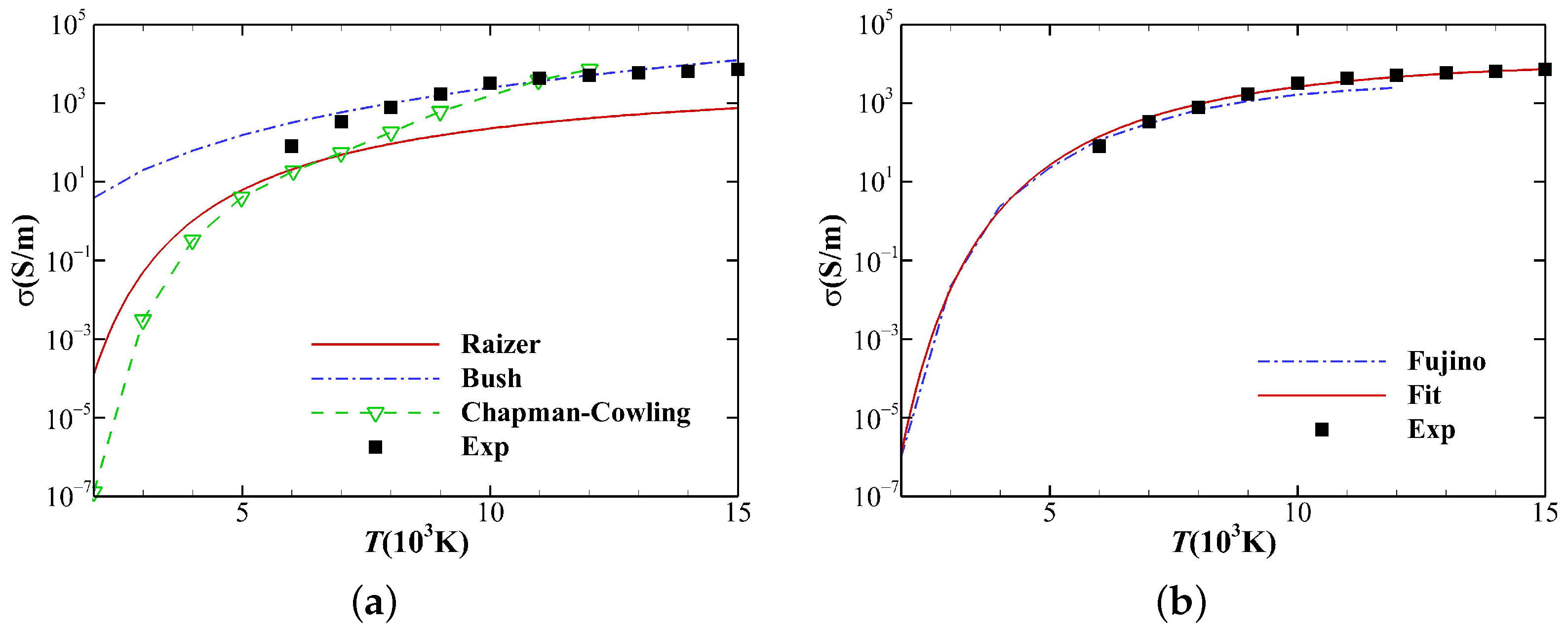
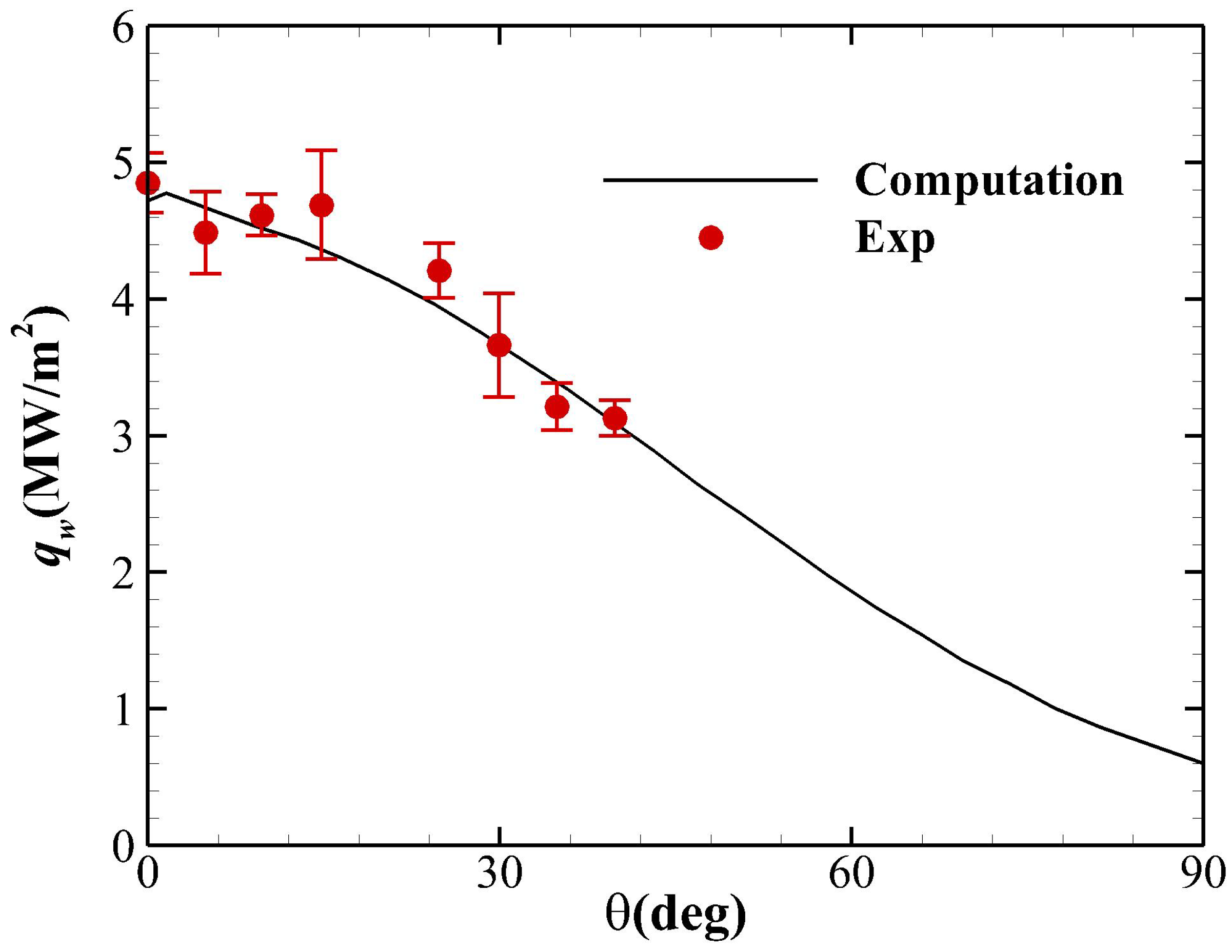
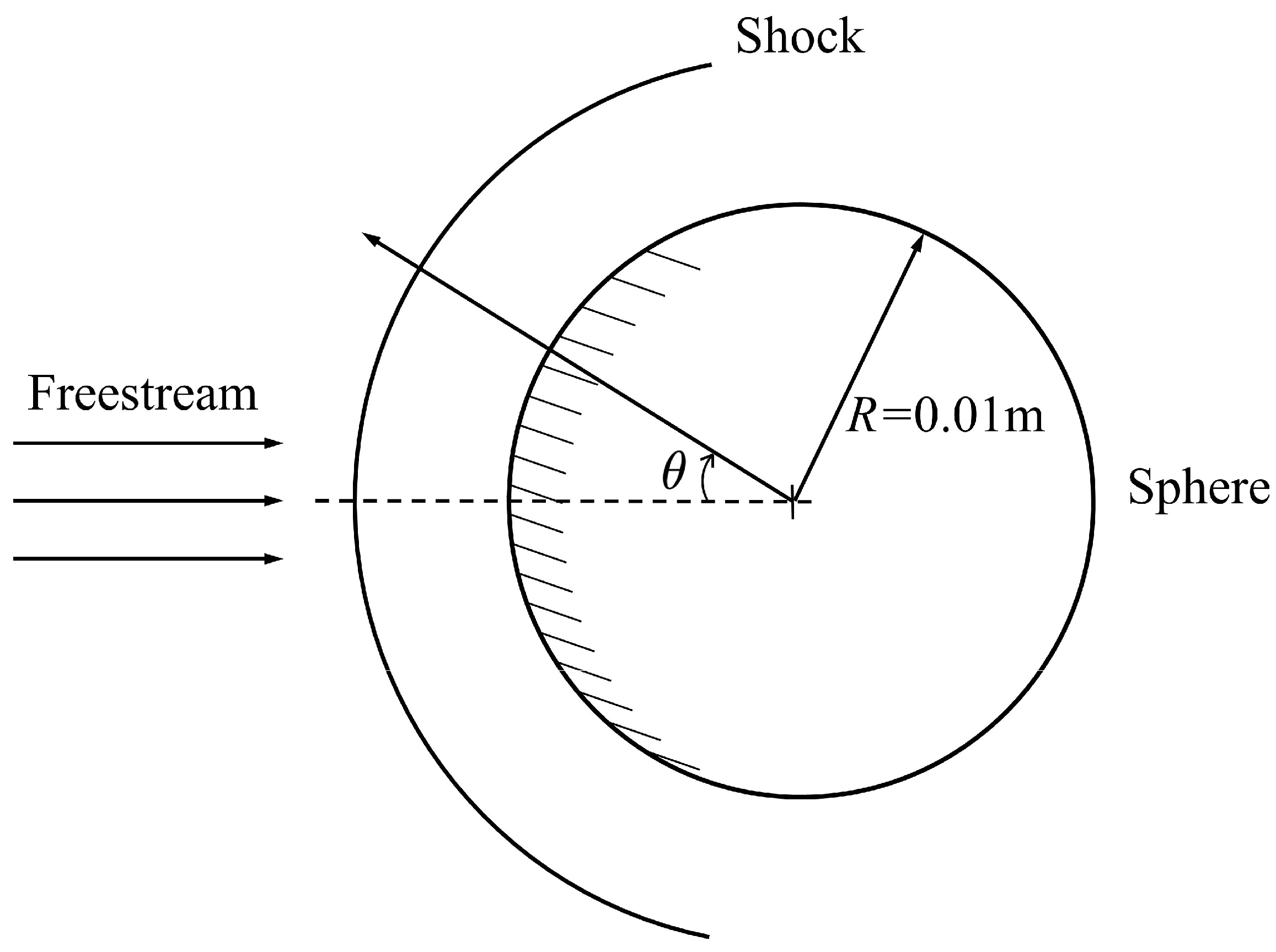
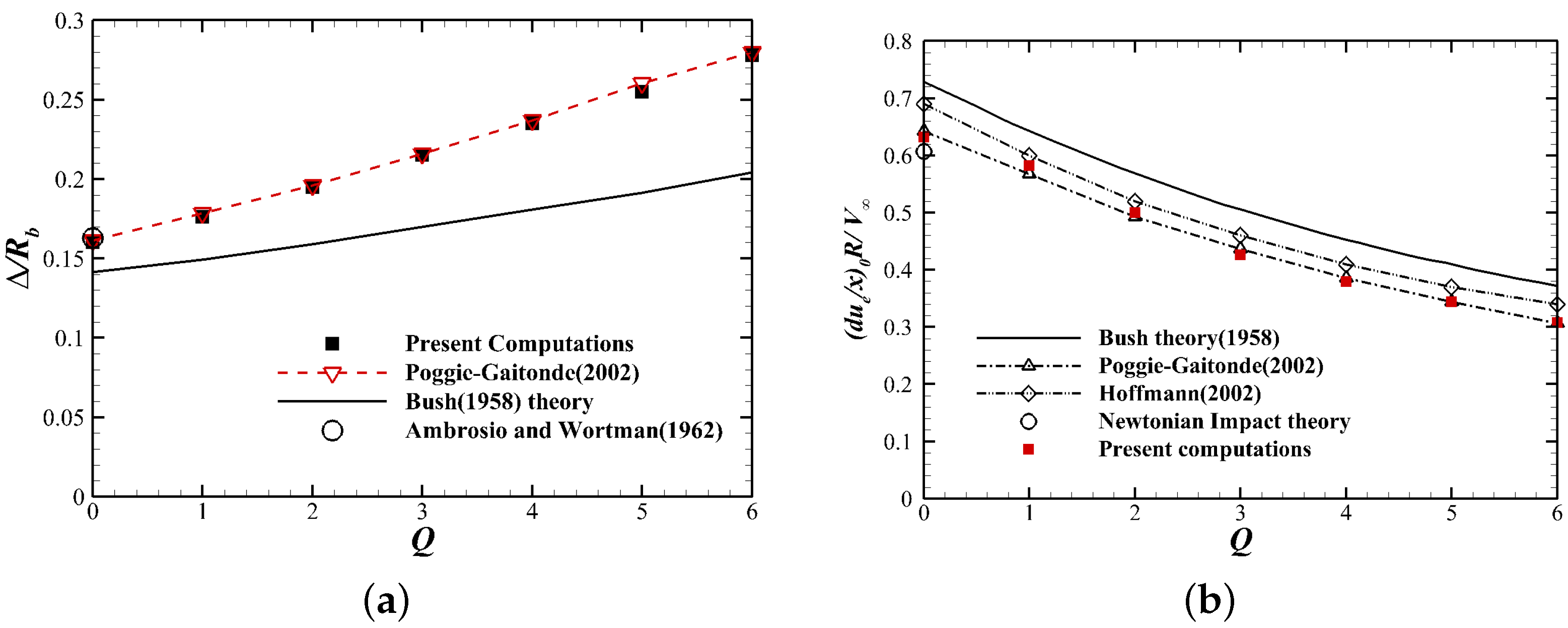
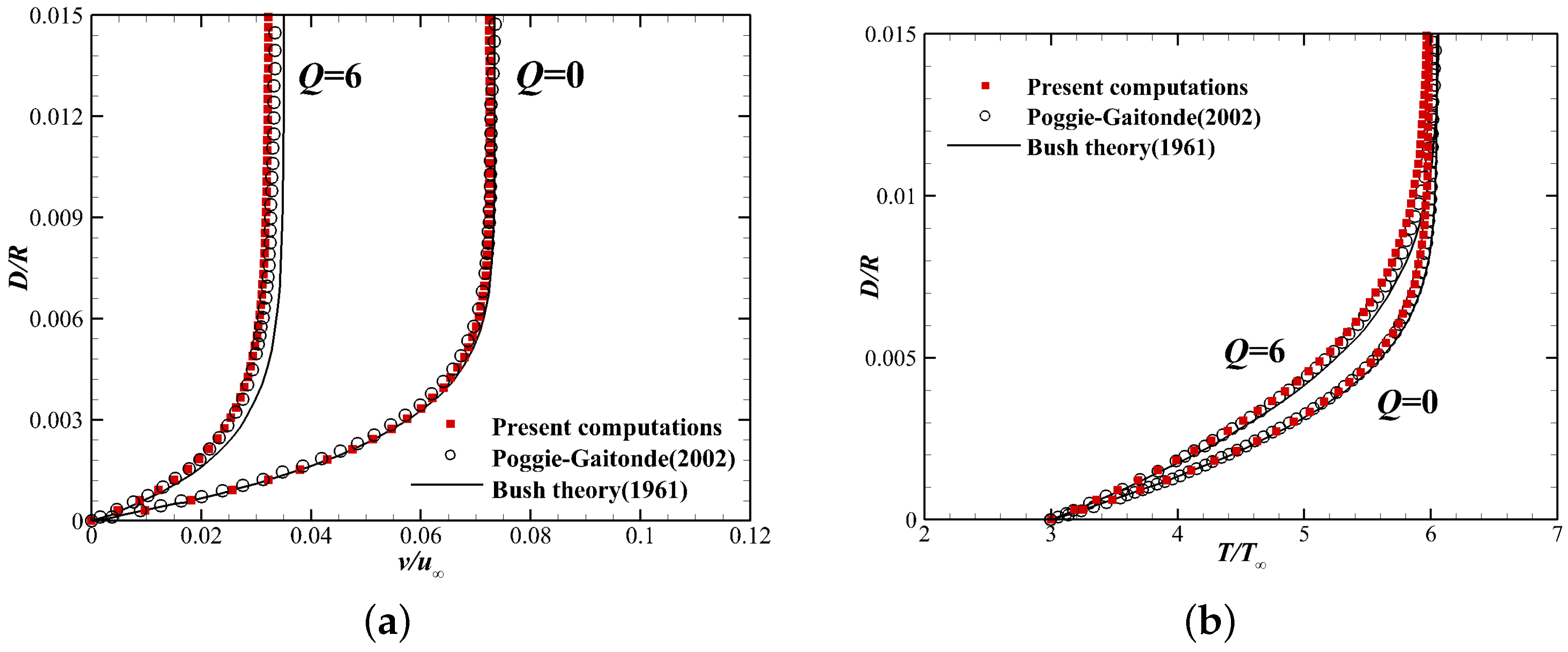

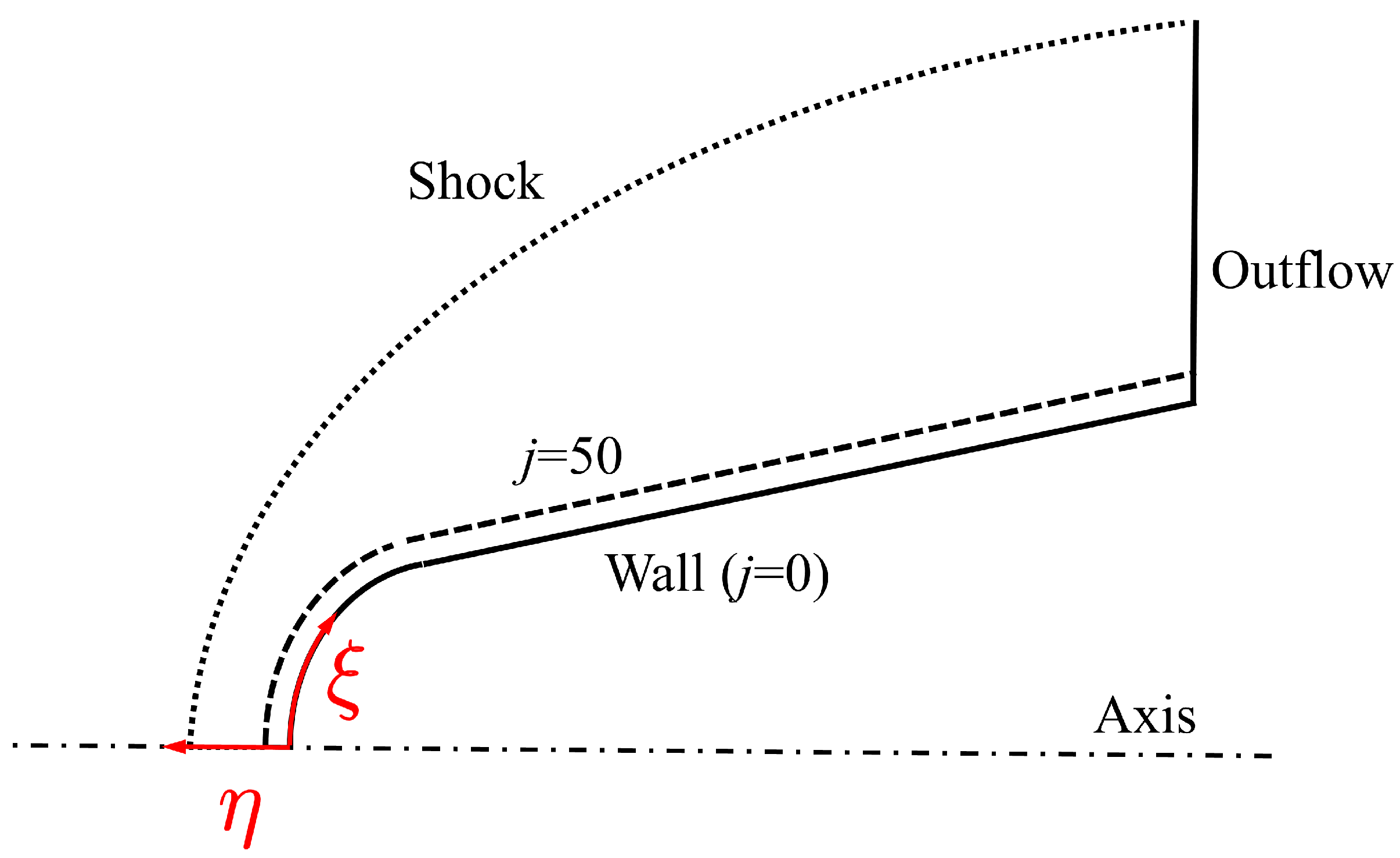


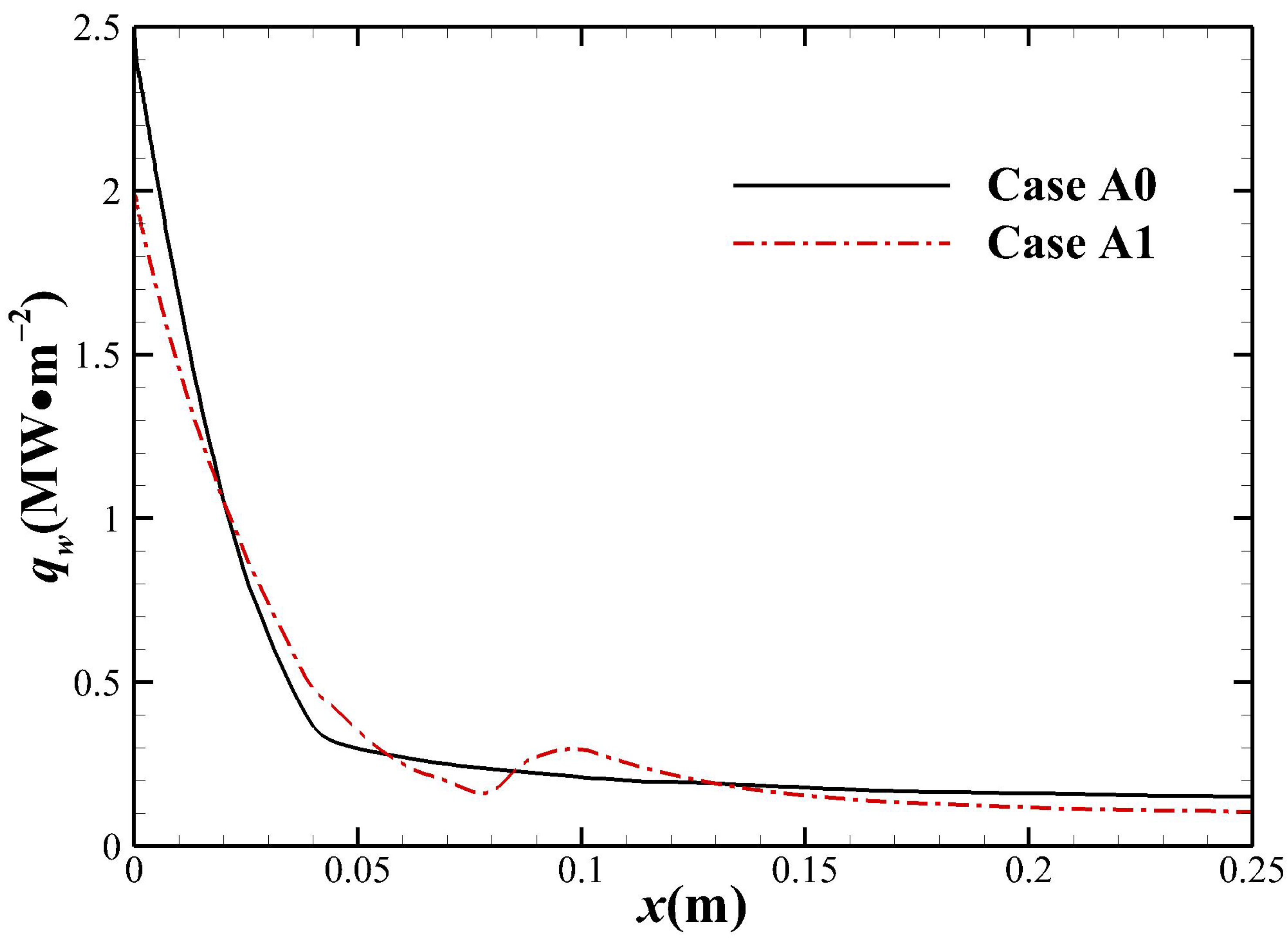
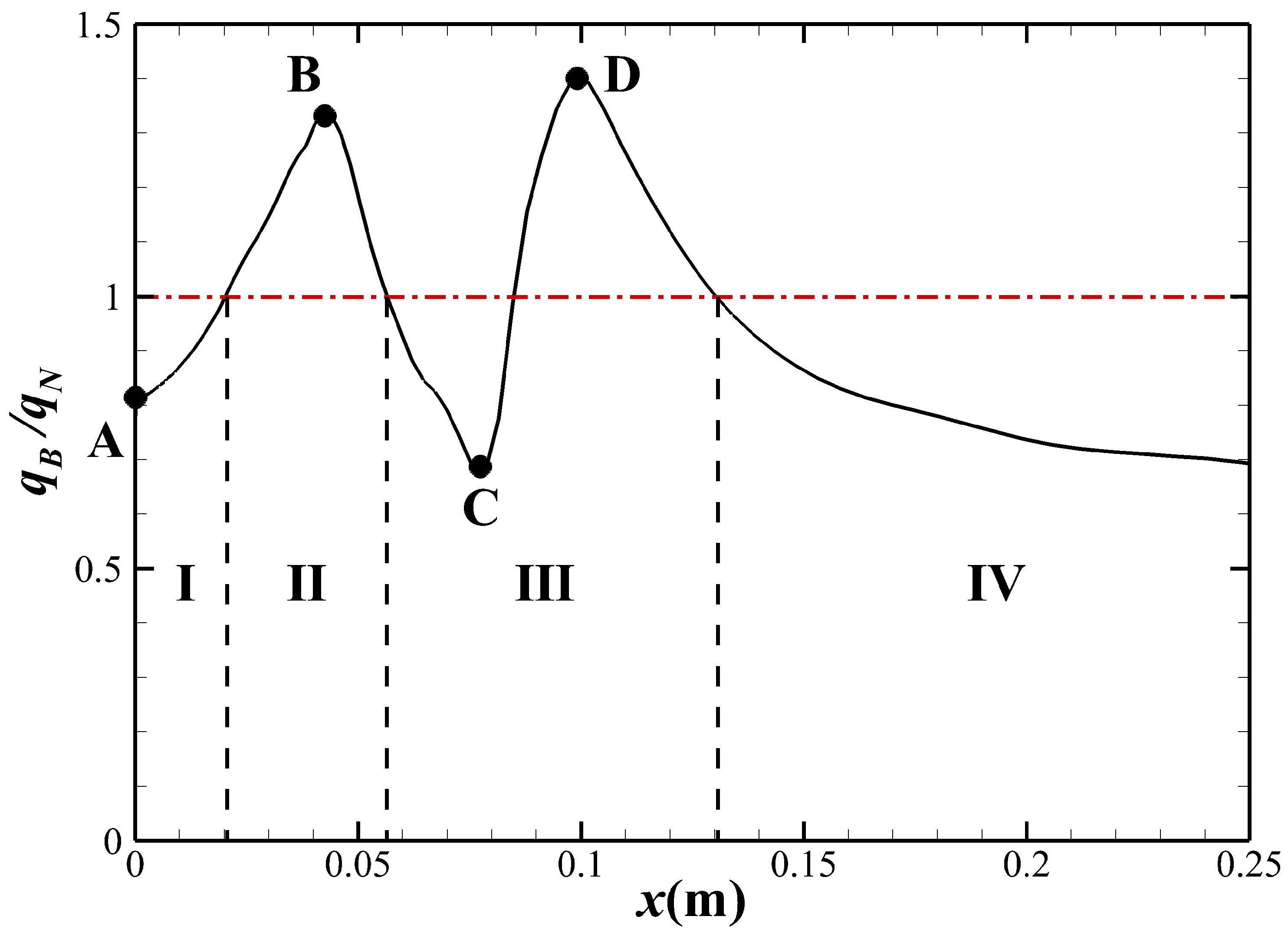
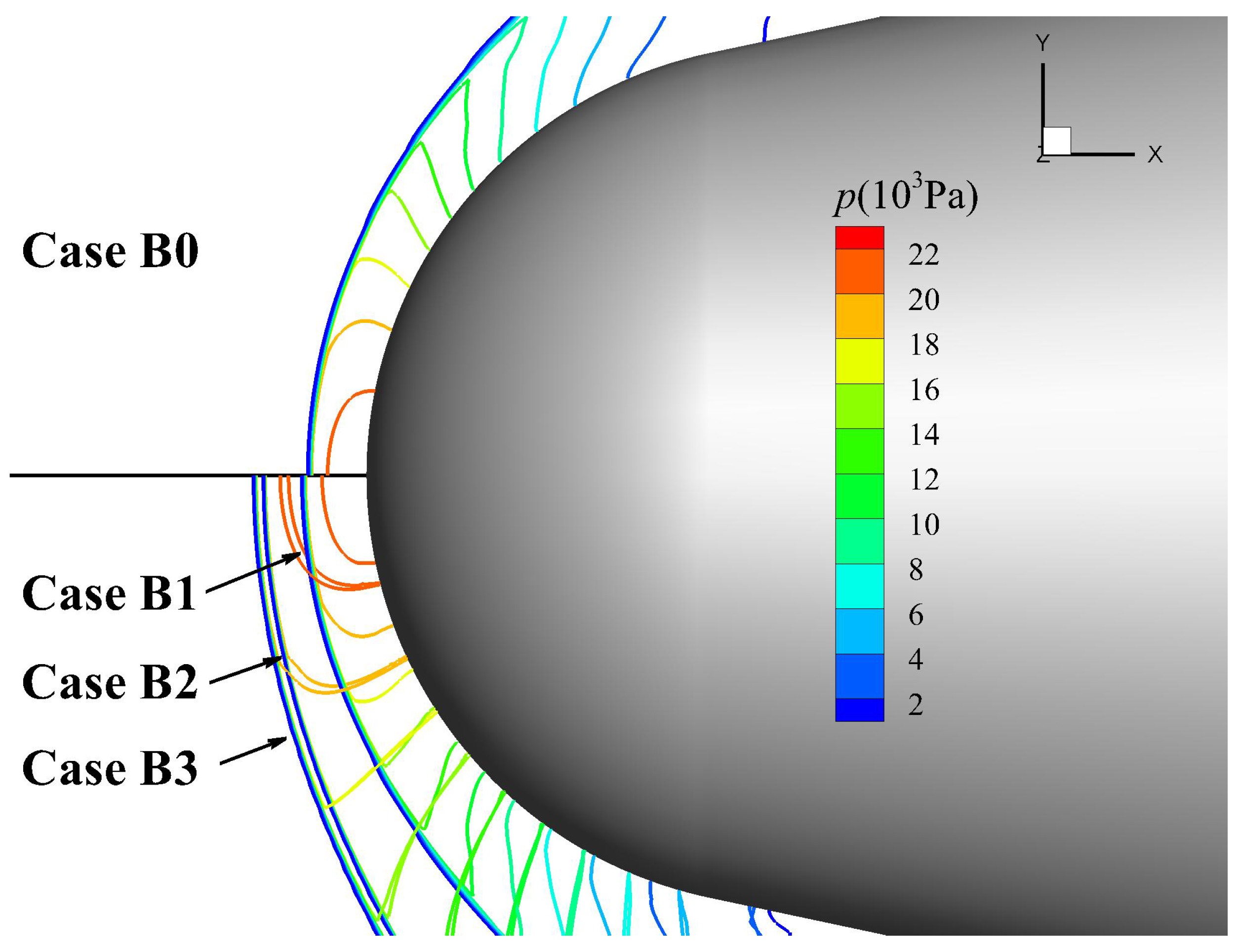
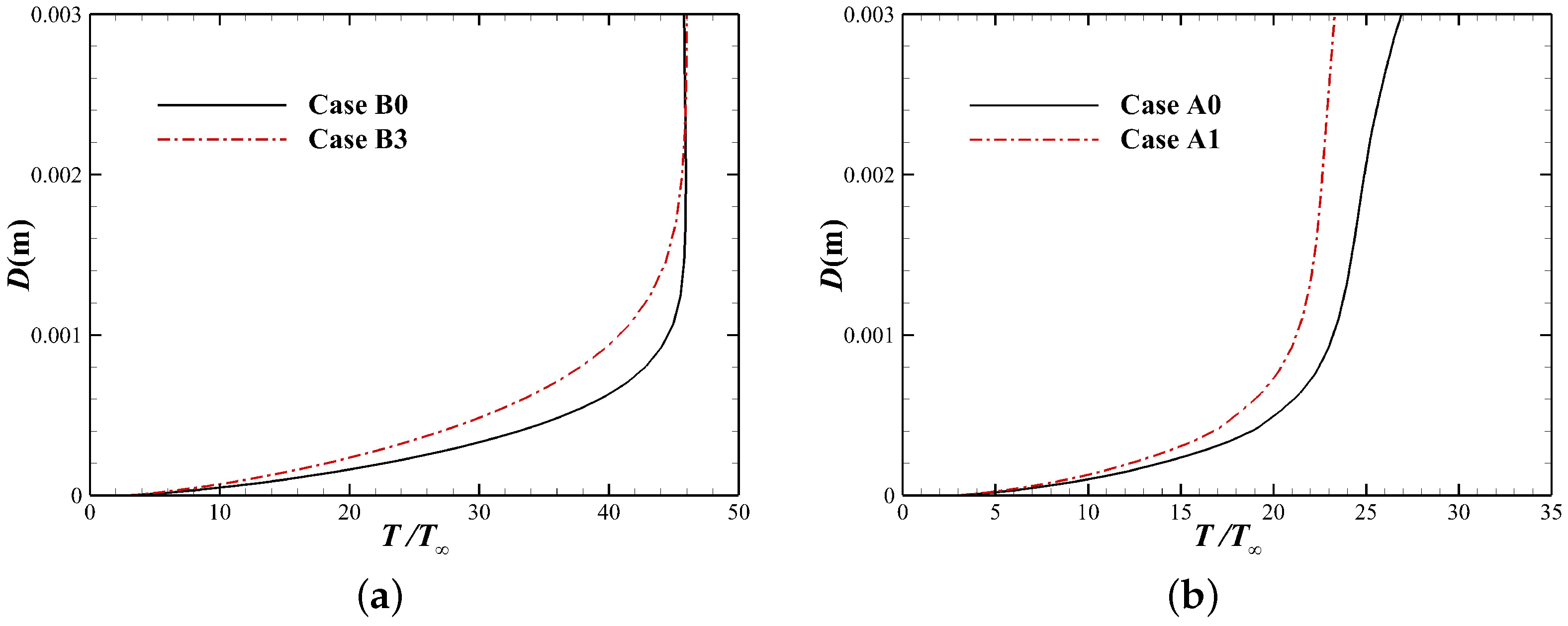
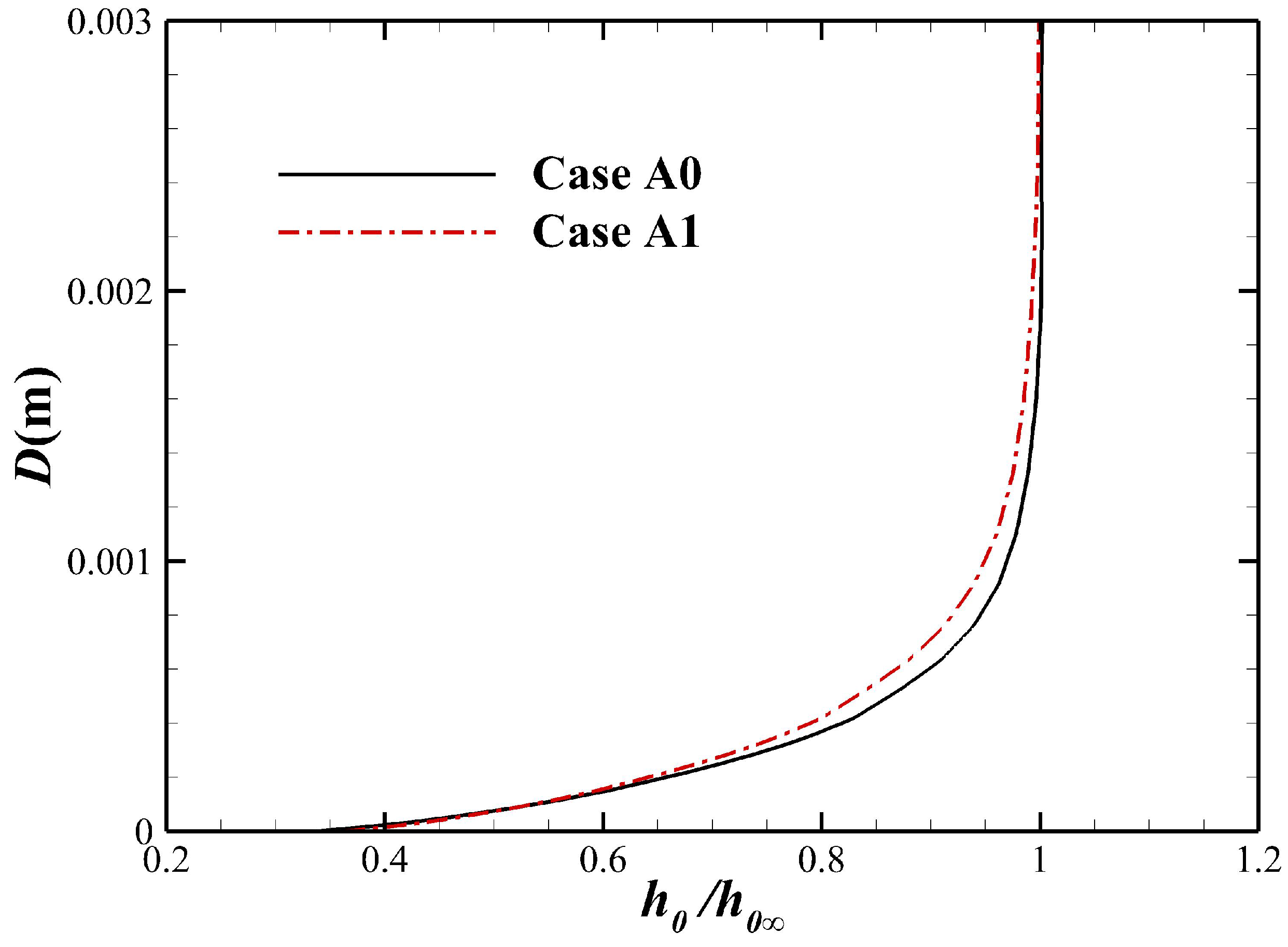
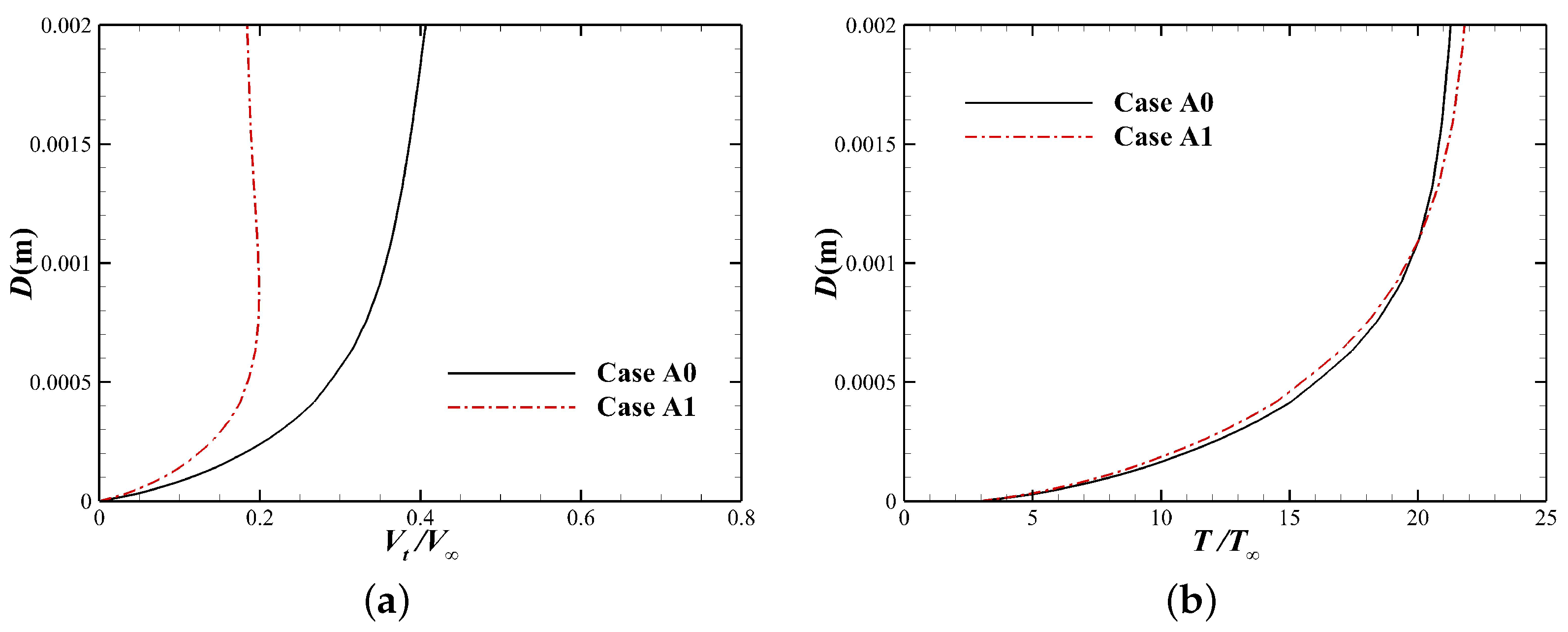

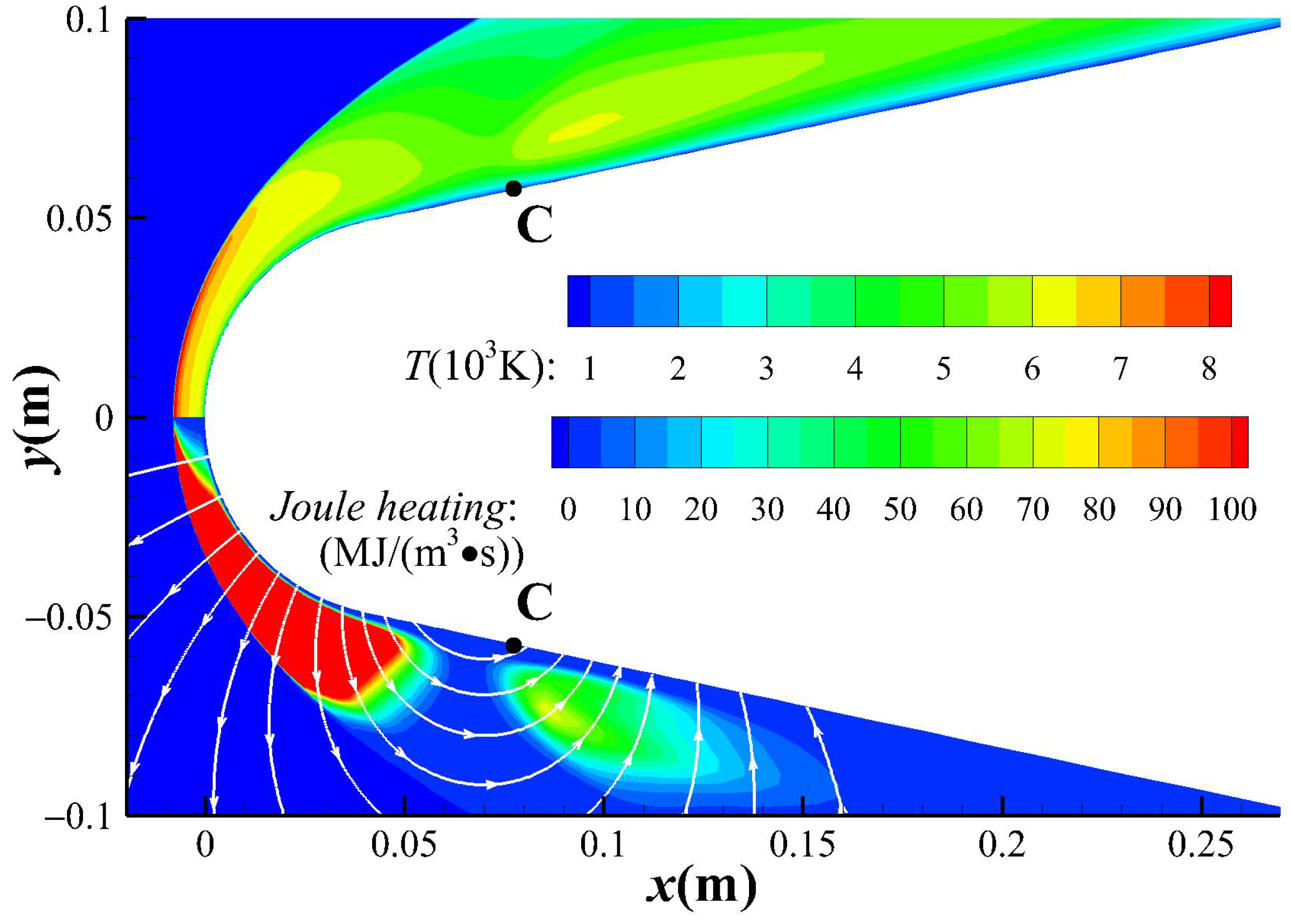

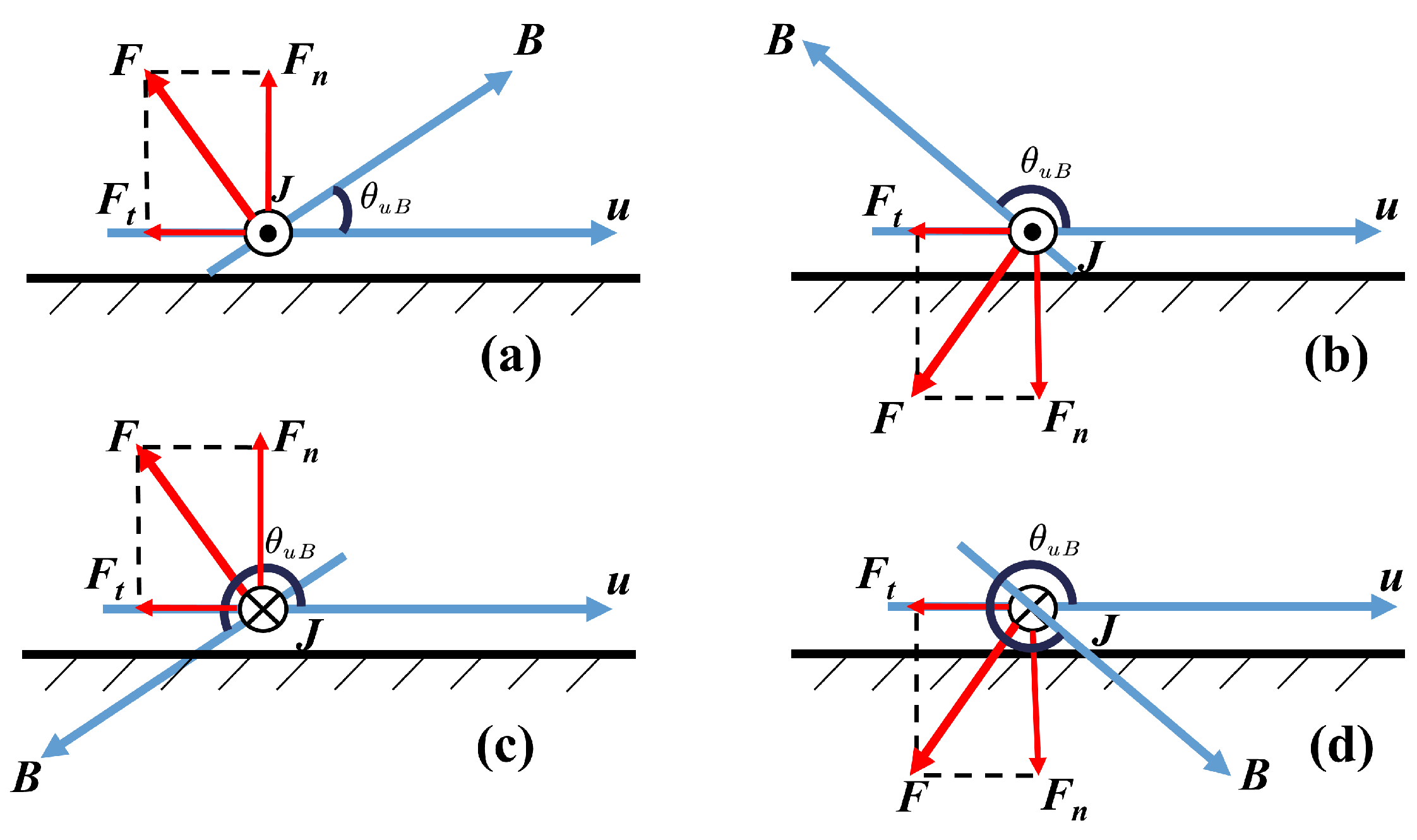
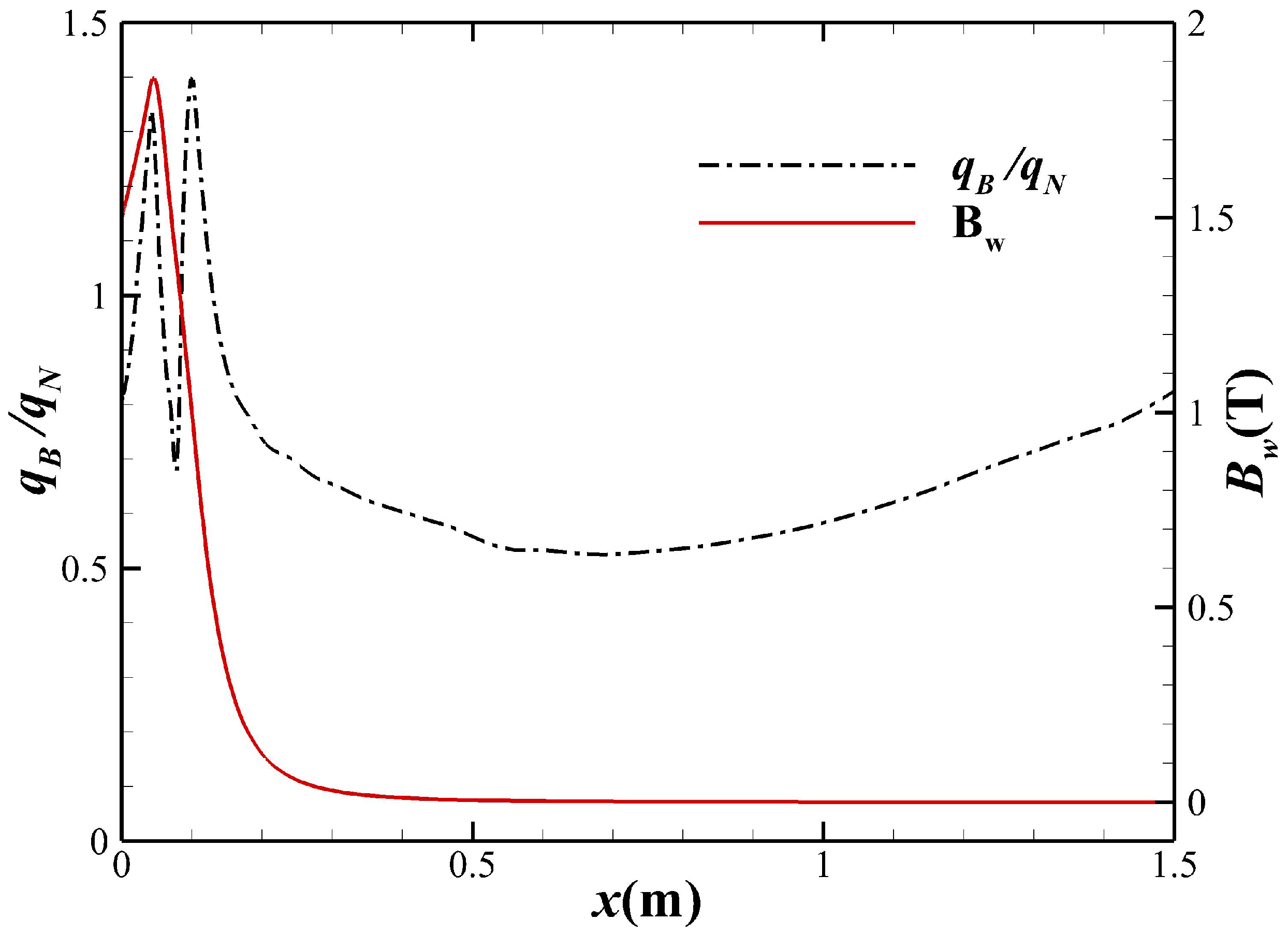
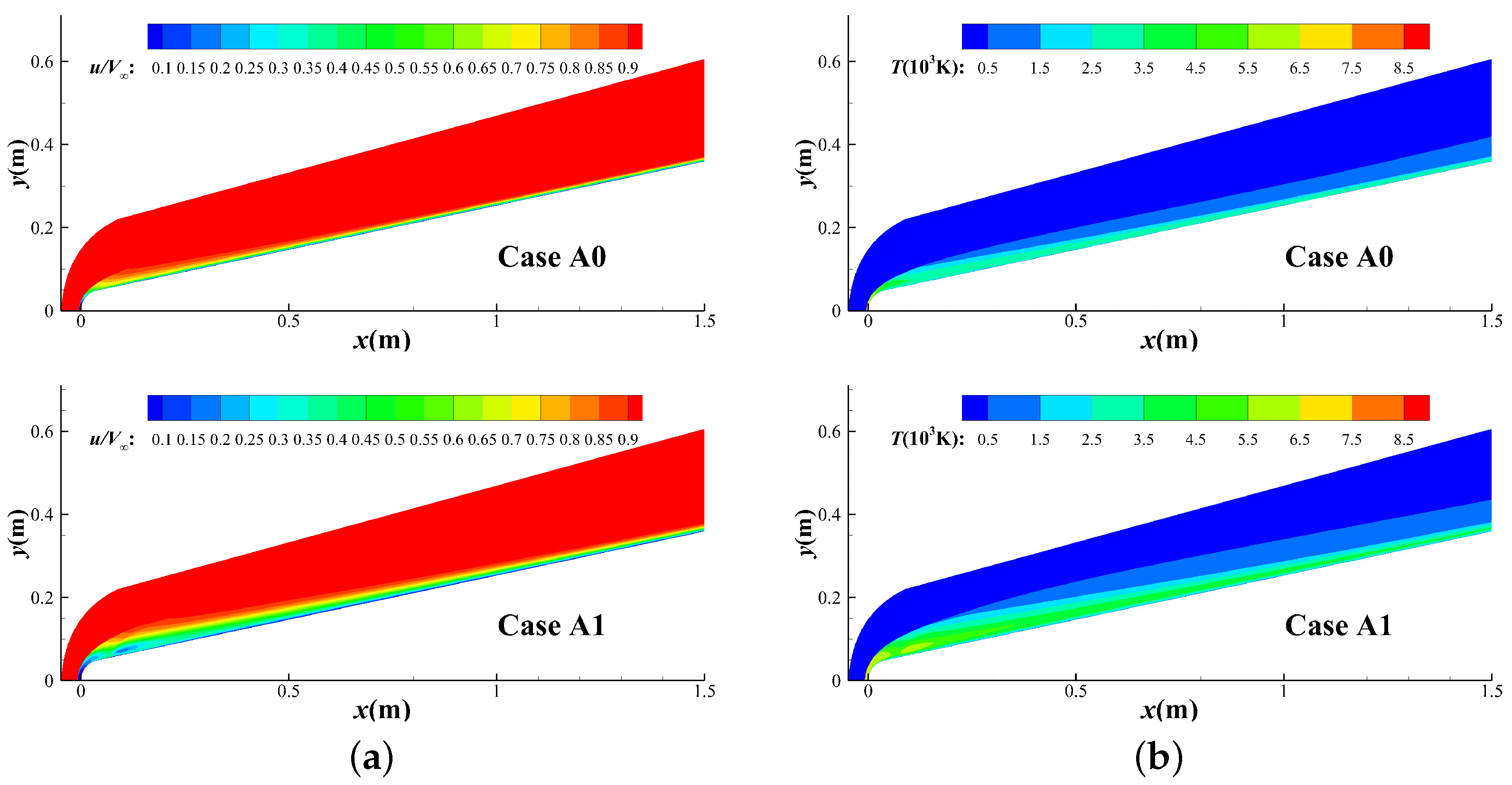
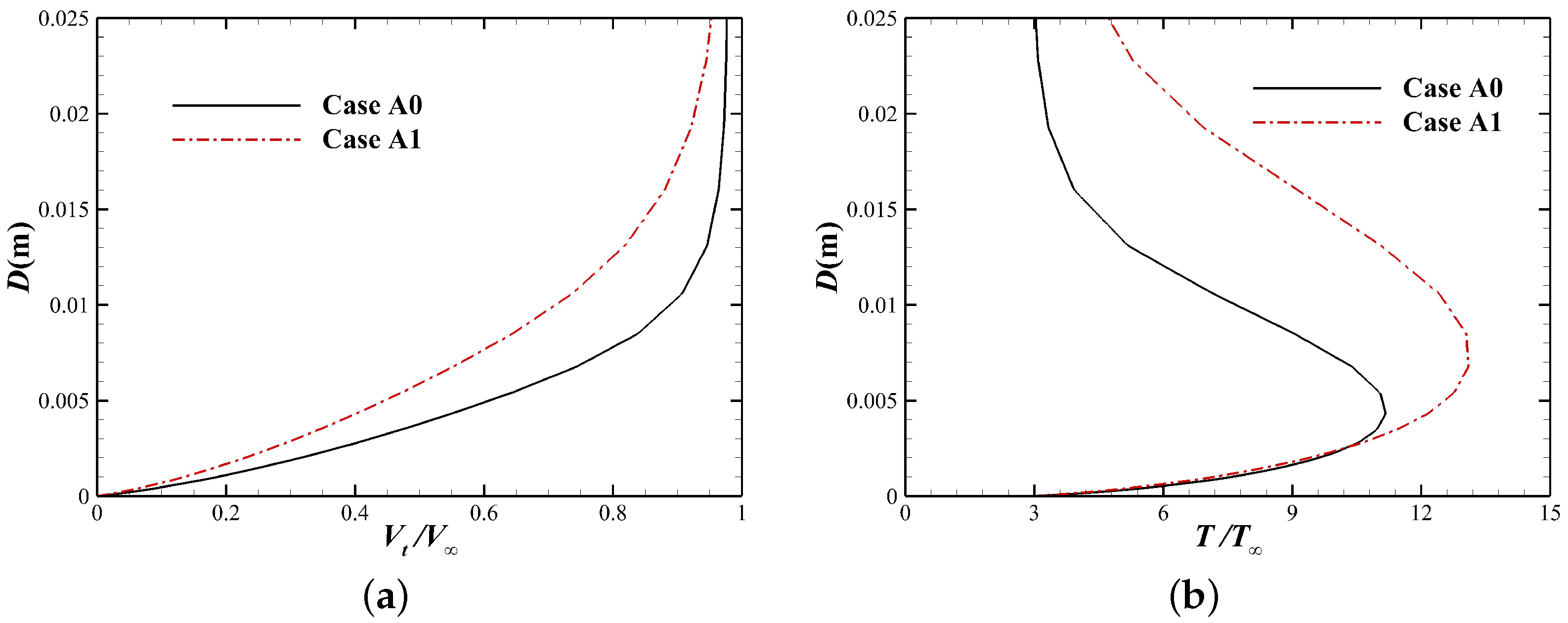
| Mach Number | Pressure | Temperature | Angle of Attack |
|---|---|---|---|
| 15 | 79.78 Pa | 270.65 K | 0 |
| Case | Chemical Kinetic Model | Electrical Conductivity |
|---|---|---|
| Case A0 | Chemical nonequilibrium | NoMHD |
| Case A1 | Chemical nonequilibrium | Fit model |
| Case B0 | Perfect gas | NoMHD |
| Case B1 | Perfect gas | S/m from wall to |
| Case B2 | Perfect gas | S/m from to shock |
| Case B3 | Perfect gas | S/m in the entire shock layer |
| Case | Case B1 | Case B2 | Case B3 |
|---|---|---|---|
| SDIR | 10.22% | 80.26% | 92.10% |
| HFDR | 16.35% | 15.75% | 30.56% |
Publisher’s Note: MDPI stays neutral with regard to jurisdictional claims in published maps and institutional affiliations. |
© 2022 by the authors. Licensee MDPI, Basel, Switzerland. This article is an open access article distributed under the terms and conditions of the Creative Commons Attribution (CC BY) license (https://creativecommons.org/licenses/by/4.0/).
Share and Cite
Zhou, Z.; Zhang, Z.; Gao, Z.; Xu, K.; Lee, C.-H. Numerical Investigation on Mechanisms of MHD Heat Flux Mitigation in Hypersonic Flows. Aerospace 2022, 9, 548. https://doi.org/10.3390/aerospace9100548
Zhou Z, Zhang Z, Gao Z, Xu K, Lee C-H. Numerical Investigation on Mechanisms of MHD Heat Flux Mitigation in Hypersonic Flows. Aerospace. 2022; 9(10):548. https://doi.org/10.3390/aerospace9100548
Chicago/Turabian StyleZhou, Zhifeng, Zhichao Zhang, Zhenxun Gao, Ke Xu, and Chun-Hian Lee. 2022. "Numerical Investigation on Mechanisms of MHD Heat Flux Mitigation in Hypersonic Flows" Aerospace 9, no. 10: 548. https://doi.org/10.3390/aerospace9100548
APA StyleZhou, Z., Zhang, Z., Gao, Z., Xu, K., & Lee, C.-H. (2022). Numerical Investigation on Mechanisms of MHD Heat Flux Mitigation in Hypersonic Flows. Aerospace, 9(10), 548. https://doi.org/10.3390/aerospace9100548








